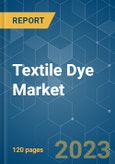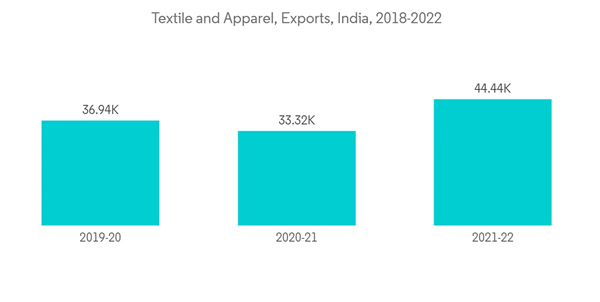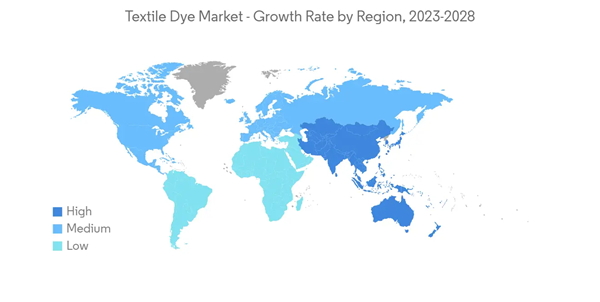The Textile Dyes market is projected to register a CAGR of more than 4% during the forecast period. COVID-19 negatively impacted the market in 2020. However, the market is now estimated to have reached pre-pandemic levels and is expected to grow steadily in the future.
This product will be delivered within 2 business days.
Key Highlights
- Over the short term, the growing demand for textile dye from the apparel industry is expected to drive the market's growth.
- The stringent environmental regulations related to textile effluent disposal are expected to hinder the growth of the market studied.
- Increasing demand for biodegradable materials for textile manufacturing is expected to act as an opportunity for the market studied.
- The Asia-Pacific region is expected to dominate the market during the forecast period owing to its growing development in major countries such as India, China, and Japan.
Textile Dye Market Trends
Increasing Demand from the Apparel Segment
- Textile dyes are widely used as colorants in the apparel industry and are expected to be the fastest-growing segment in the market during the forecast period.
- Dyes are used for coloring fabrics. Dyes absorb and reflect light at a specific wavelength, giving the human eye a sense of color. Dyes impart beauty to the fabrics.
- With the increased internet penetration, consumers are now looking for easy shopping, better offers, and easy return policies. The growth in online sales contributed to the apparel industry's growth.
- Nowadays, clothing is a symbol of aspiration, personality, and status. Consumers have shifted from need-based to aspiration-based clothing. The demand for aspiration clothing increased, which is expected to drive the textile dyes market.
- India is a global leader in producing numerous textile products, including silk, cotton, and Multimode Fibre. According to the report published on September 2022 by IBEF, the Indian textile and apparel sector is worth over USD 100 billion and contributes 14% of the nation's industrial output.
- Furthermore, about 15% of India's export revenue comes from the textile industry. 10.6% of India's total exports in FY22 were textiles, handicrafts, and clothing.
- Therefore, the above factors are expected to impact the textile dye market in the coming years significantly.
Asia-Pacific to Dominate the Market
- Asia-Pacific is expected to dominate the market for textile dyes during the forecast period due to increased demand from countries like India and China.
- Textile dyes are mainly used as colorants for fabric in apparel and household textiles. The growing population is expected to drive the demand for clothing, propelling the textile dyes market during the forecast period.
- China is one of the most attractive countries for clothing manufacturing due to relatively low labor costs and fewer commercial obstacles. A rising number of Chinese textile enterprises are focusing on updating their industrial infrastructure and modernizing their manufacturing processes to expand the industry further.
- According to the National Bureau of Statistics of China, the country manufactured 3.18 billion m of textile for garments as of October 2022. The textiles produced each month were consistently greater than 3 billion m. Hence positively impacting the market growth.
- Moreover, the Indian government sanctioned the development of seven PradhanMantri Mega Integrated Textile Region and Apparel (PM MITRA) Parks at Greenfield/Brownfield sites for a total investment of around USD 600 million for the 2027-28 period. Such investments are expected to benefit the market growth during the forecast period.
- Therefore, owing to the factors above, are Asia-Pacific region is expected to dominate the textile dye market in the coming years.
Textile Dye Market Competitor Analysis
The textile dye market is fragmented in nature. Some of the major players in the market include Vipul Organics Ltd, DEV COLOURS, DyStar Singapore Pte Ltd, Archroma, and Huntsman International LLC, among others. (in no particular order).Additional benefits of purchasing the report:
- The market estimate (ME) sheet in Excel format
- 3 months of analyst support
This product will be delivered within 2 business days.
Table of Contents
1 INTRODUCTION1.1 Study Assumptions
1.2 Scope of the Study
2 RESEARCH METHODOLOGY
3 EXECUTIVE SUMMARY
4 MARKET DYNAMICS
4.1 Drivers
4.1.1 Growing Demand from the Apparel Industry
4.1.2 Other Drivers
4.2 Restraints
4.2.1 Stringent Environmental Regulations Related to Textile Effluent Disposal
4.2.2 Other Restraints
4.3 Industry Value Chain Analysis
4.4 Porter's Five Forces Analysis
4.4.1 Bargaining Power of Suppliers
4.4.2 Bargaining Power of Buyers
4.4.3 Threat of New Entrants
4.4.4 Threat of Substitute Products and Services
4.4.5 Degree of Competition
5 MARKET SEGMENTATION (Market Size in Value)
5.1 Dye Type
5.1.1 Reactive
5.1.2 Dispersive
5.1.3 Direct
5.1.4 VAT
5.1.5 Basic
5.1.6 Acidic
5.1.7 Other Dye Types
5.2 Fiber Type
5.2.1 Wool
5.2.2 Nylon
5.2.3 Cotton
5.2.4 Polyester
5.2.5 Viscose
5.2.6 Acrylic
5.2.7 Other Fiber Types
5.3 Application
5.3.1 Apparel
5.3.2 Household Textiles
5.3.3 Industrial Fabrics
5.3.4 Other Applications
5.4 Geography
5.4.1 Asia-Pacific
5.4.1.1 China
5.4.1.2 India
5.4.1.3 Japan
5.4.1.4 South Korea
5.4.1.5 Rest of Asia-Pacific
5.4.2 North America
5.4.2.1 United States
5.4.2.2 Canada
5.4.2.3 Mexico
5.4.3 Europe
5.4.3.1 Germany
5.4.3.2 United Kingdom
5.4.3.3 Italy
5.4.3.4 France
5.4.3.5 Rest of Europe
5.4.4 South America
5.4.4.1 Brazil
5.4.4.2 Argentina
5.4.4.3 Rest of South America
5.4.5 Middle-East and Africa
5.4.5.1 Saudi Arabia
5.4.5.2 South Africa
5.4.5.3 Rest of Middle-East and Africa
6 COMPETITIVE LANDSCAPE
6.1 Mergers and Acquisitions, Joint Ventures, Collaborations, and Agreements
6.2 Market Share (%)**/Ranking Analysis
6.3 Strategies Adopted by Leading Players
6.4 Company Profiles
6.4.1 Akik Dye Chem
6.4.2 Archroma
6.4.3 Blendwell SA
6.4.4 DEV COLOURS
6.4.5 DyStar Singapore Pte Ltd
6.4.6 Huntsman International LLC
6.4.7 Jiangsu World Chemical Co. Ltd
6.4.8 KeyColour
6.4.9 Mahickra Chemicals Limited
6.4.10 Organic Dyes and Pigments
6.4.11 Royce Global
6.4.12 S.A. Robama
6.4.13 Sun Chemical
6.4.14 Vipul Organics Ltd
7 MARKET OPPORTUNITIES AND FUTURE TRENDS
7.1 Development of Eco-friendly Textile Dyes
Companies Mentioned (Partial List)
A selection of companies mentioned in this report includes, but is not limited to:
- Akik Dye Chem
- Archroma
- Blendwell SA
- DEV COLOURS
- DyStar Singapore Pte Ltd
- Huntsman International LLC
- Jiangsu World Chemical Co. Ltd
- KeyColour
- Mahickra Chemicals Limited
- Organic Dyes and Pigments
- Royce Global
- S.A. Robama
- Sun Chemical
- Vipul Organics Ltd
Methodology

LOADING...










